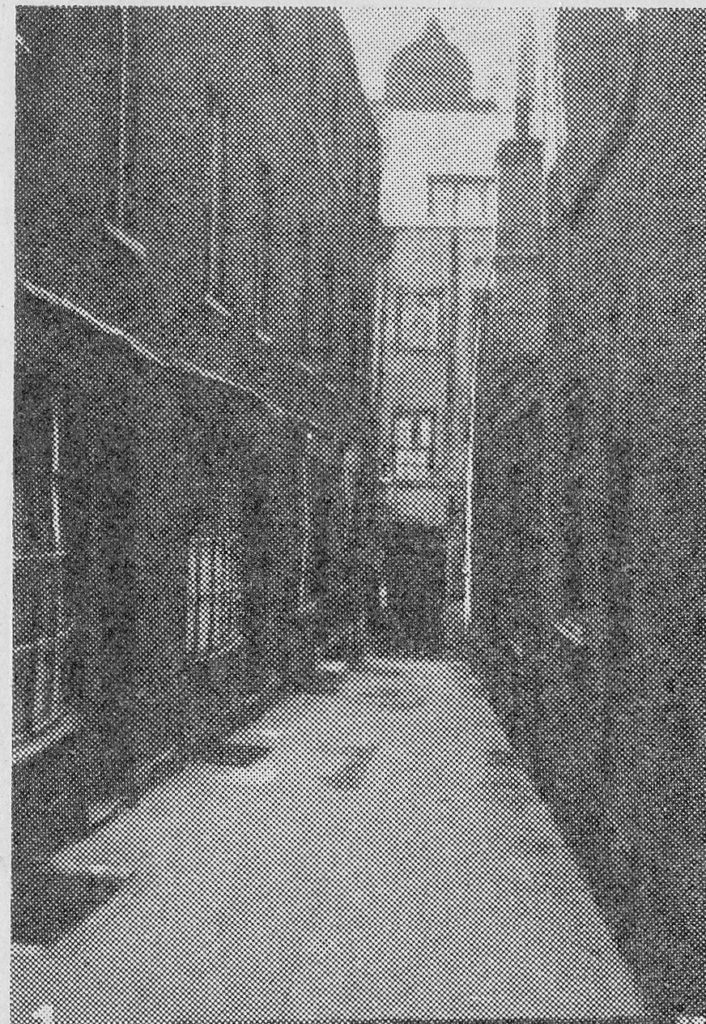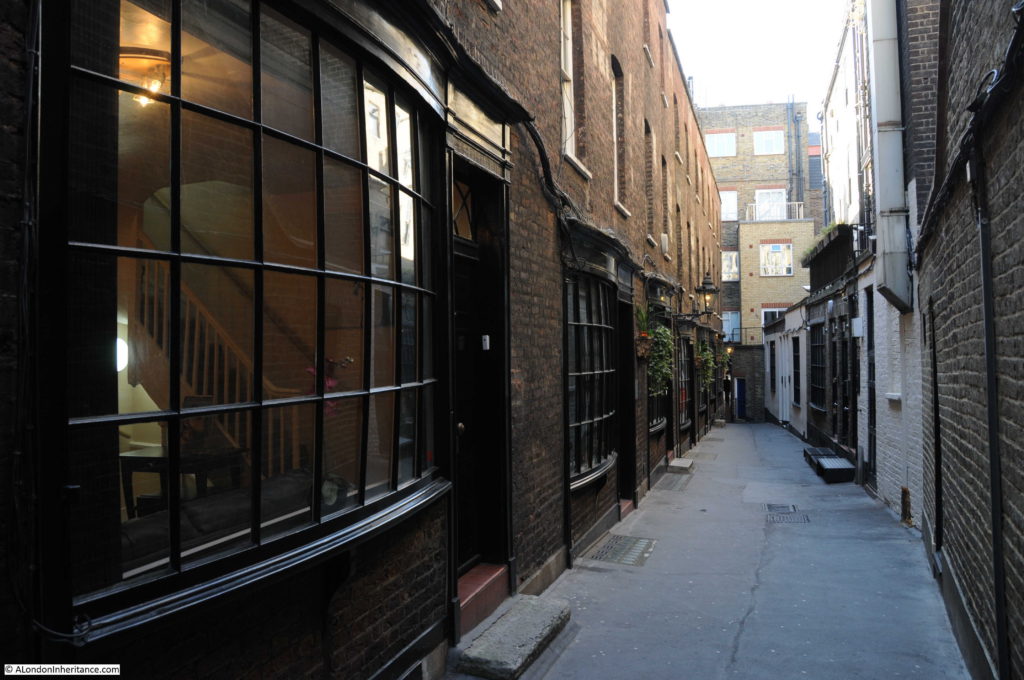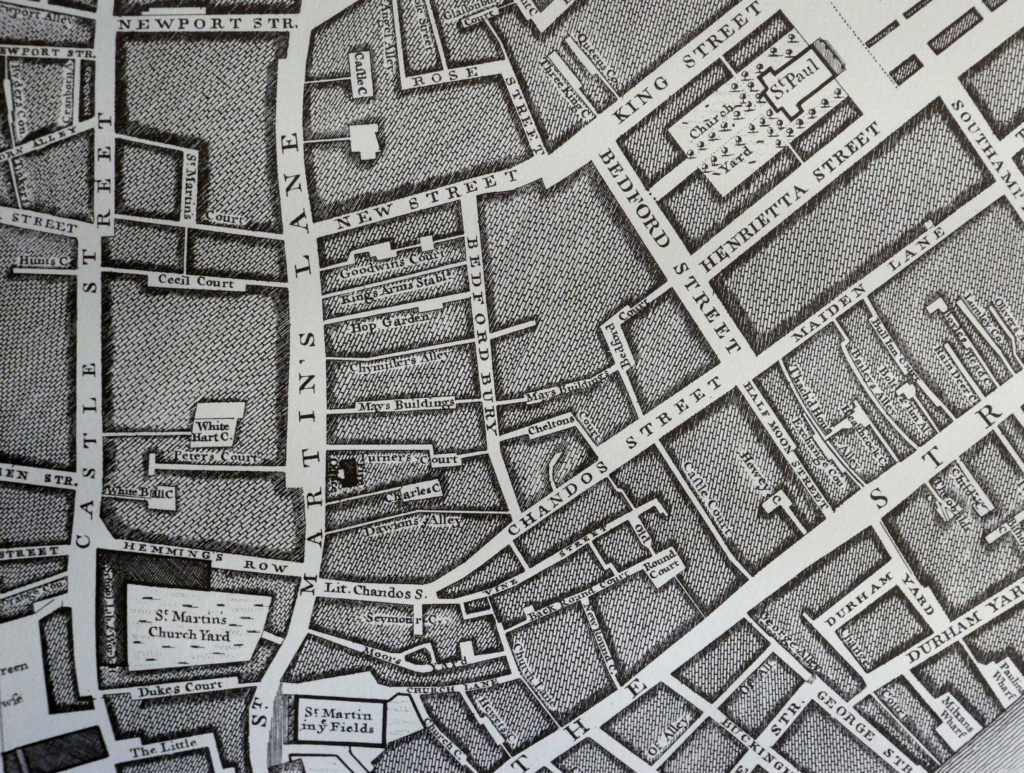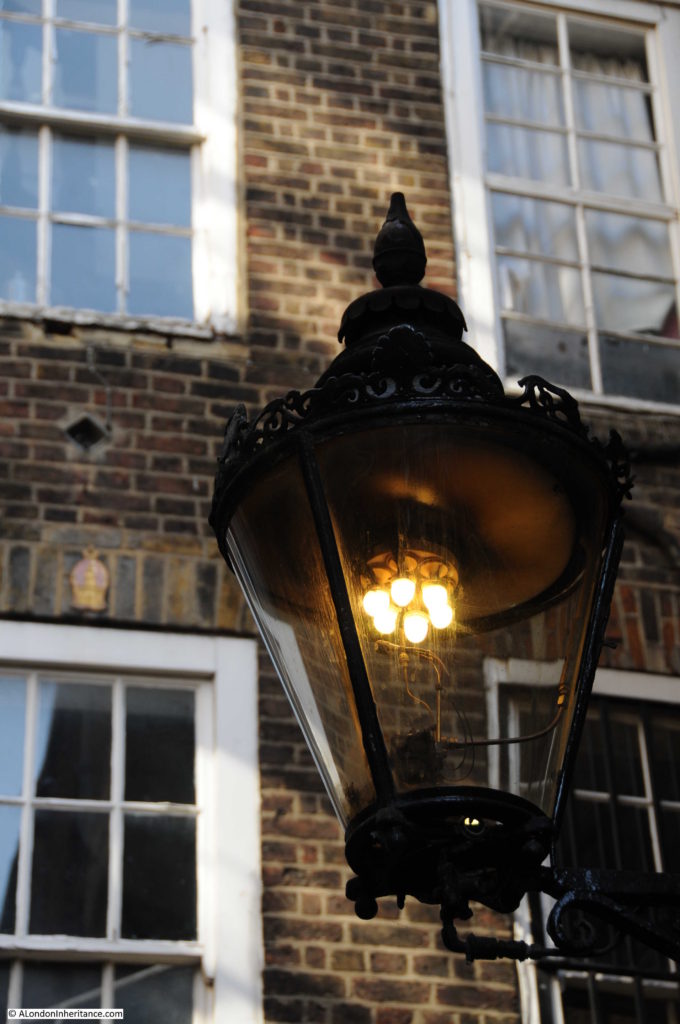A couple of months ago, I wrote about XX Place in Stepney. It was a location I found in the little book Curious London by Hugh Pearman, published in 1951.
Pearman divided the city up into ‘towns’ and identified six locations of interest in each of these towns.
The book is fascinating as it provides a whole range of different locations to visit, places I may not normally visit, to see if the items of interest in each of the areas Pearman defined as a town are still there, and to learn a bit more about London.
I was recently in Westminster and checked the book for any interesting detours, and found a reference to Goodwin’s Court, with the following text:
“This unique row of delightful bow-fronted cottages forms one side of Goodwins Court, an old-world thoroughfare off S. Martin’s Lane. In one of the cottages lived Nell Gwynn the orange seller at the nearby Drury Lane Theatre, who became the sweetheart of the ‘Merry Monarch’ and the darling of the populace. The narrow windows are still iron-barred, although the dungeon like cells have been empty for many, many years.”
The book included the following rather grainy photograph of Goodwin’s Court showing a dark alley, with the bow-fronted cottages on the left.
Goodwin’s Court is a narrow alley running between St. Martin’s Lane and Bedfordbury, a busy area in the West End, just north of Trafalgar Square. The entrance from Bedfordbury is through an alley in two of the houses which look to be contemporary with the buildings in the court and have the same style of bow fronted windows.
A plaque along Goodwin’s Court dates the houses to 1690:
The view along Goodwin’s Court from the Bedfordbury end. The original 17th century terrace is along the southern side of the Court. Each has a bow fronted window on the ground floor with two additional floors above.
Compare this photo with the 1951 photo at the top of the post and it can be seen that the court has hardly changed.
If the houses were built in 1690, they would have been over 50 years old when John Rocque printed his map of London in 1746.
The following map extract shows Goodwin’s Court as one of a number of narrow streets or alleys between St. Martin’s Lane and Bedfordbury (which looks as if it may have been two separate words in 1746). Goodwin’s Court is at the top, just below New Street.
As well as Goodwin’s Court, some of these other alleys can still be found, including Hop Gardens and May’s Court, although in 1746 the name was May’s Buildings.
One point I cannot reconcile between the age of the houses and Rocque’s map is that the map shows a much wider open space on the left of the alley and another open square space on the right with only a short straight section between. The map does not mirror the straight line of terrace houses along the majority of the southern side of the court, if they were indeed built around 1690.
All the sources dating the houses to 1690 seem to refer to the same rate book reference as appears on the plaque in the Court, so perhaps an error in Rocque’s map or perhaps the terrace of houses was built later.
The view from half way along the court looking towards St. Martin’s Lane.
As can be seen, the houses run all the way to the covered alley which leads under the buildings along the side of St. Martin’s Lane. The alley does indent to the left here so perhaps the surveyors of Rocque’s map just made an error, or did not investigate the court in detail.
For the whole time I was in Goodwin’s Court there were no other pedestrians using the route as a short cut between St. Martin’s Lane and Bedfordbury, despite the surrounding streets being busy. It really was like walking into a hidden court as no one else followed, the only exception being two tour groups. Both groups seemed to focus on a Harry Potter reference for the street.
One of the groups was in English and the tour leader was describing the alley as the inspiration for Diagon Alley in the Harry Potter films, and that the location could not be used for filming as the alley was too narrow for the required equipment.
The second tour group was Spanish, but the words Diagon Alley and Harry Potter were mentioned several times so I assume the theme of the visit to Goodwin’s Court was the same for both tour groups.
I have no idea whether there is any truth in these references, however there are numerous Internet references to Goodwin’s Court being Diagon Alley, but also many Internet sites that claim Cecil Court to be the inspiration for Diagon Alley with Harry Potter fans apparently split between the two options.
I much prefer the fact that there is a terrace of houses along Goodwin’s Court that are probably over 300 years old.
In curious London, Pearman stated that “In one of the cottages lived Nell Gwynn the orange seller at the nearby Drury Lane Theatre”. Given that Nell Gwynn died in 1687 it would not have been in one of the existing houses in Goodwin’s Court and I can find no reference to confirm that she ever did live in Goodwin’s Court, however I did find an Internet reference to one of the houses having a plaque above the door stating an association with Nell Gywnn – I did not notice this on my visit.
What ever the truth behind the inspiration for Diagon Alley, or Nell Gwynn, Goodwin’s Court is a perfect example of the many alleys that could once be found in this part of London.









Very nice. Thanks.
Nice find, I’ll look out for it.
Beautiful place. I walked around the area in the 1980’s and was so surprised to find such a gem.
To my inexpert eye the houses in Goodwin’s Court don’t look as old as 1690. Almost all the items thrown up by a Google search give their date as 1690, apparently relying on the Survey of London, which is the same source as the plaque. However, Historic England’s official listing for Goodwin’s Court (https://www.historicengland.org.uk/listing/the-list/list-entry/1066764) describes the houses as late 18th century. That’s much more consistent with their appearance. Curiously, the only source mentioned in the listing is the Survey of London.
There are several ‘Diagon Alley’ locations as the alley in the film was made up of several locations (using CGI) in and around London including Leadenhall Market.
I ‘discovered’ Goodwin’s Court in the 1970s when I worked in Covent Garden and I used it as a short cut to Leicester Square underground station.
Hugh Pearman writes “in the narrow windows are still iron barred, although the dungeon like cells have been empty for many years.” This I believe refers to the St Martin’s Parish Lockup which was at the St Martin’s Lane end of Goodwin’s Court, and not to Nell Gwynn’s house, if it was there at all!
As a Londoner in the mid-60s/early-70s, I well remember Goodwin’s Court as a detour rather than a shortcut off St Martin’s Lane, taken precisely to see those bow windows & bask in the glimmer of 18th century London. Obviously, I’m of a mind that these are 18th rather than 17th century buildings. And. as I recall, a few were ground floor shops. Is that still the case?
Thank you for posting this. After 20 years away from London, having lived there as an American expat in my 20s, I returned in 2015 on business and have spent a great deal of time there since. I “discovered” Goodwin’s Court early last year and make it a point to cut through it anytime I’m in the vicinity on one of my walks around town. What a gem it is, tucked away through those enticing doorways into the alley.
As always, I appreciate the blog and the wonderful stories and vintage photos you post comparing various areas during your father’s time with how they appear today. You’ve given me ideas for places to seek on future visits, too.
My gut feeling is that those buildings are later than 17th century. They all appear to be of Flemish Bond construction. Flemish Bond was starting to be used from the late 17th century but the new technique would have taken time to permeate the bricklaying fraternity and with these buildings not being high status I would think they are likely to be from well into the 18th century. The new method of bonding bricks would have been used on grander buildings to begin with.
Interesting as ever. Thank you.
I actually live off Drury Lane. I have a Peabody flat & i’m so grateful. London’s history really comes to life for me, living in Central London. I’m a Londoner through & through. I love old pubs. Sam Smiths ate the best. I love a proper builder’s cup o tea. I love walking round olde streets of my London town. This alleyway is my most favourite in the whole of the city. I love getting lost in the past. Feeling i’ve gone back in time. I try to avoid thinking how London would have smelt before our sewers were put in place. The stink would have made your eyes water!!! But London’s meant to be grubby, edgy, seedy. I cry when i think of them cleaning up Soho. Bring back the muck!!!! Plus. I always love your website. Thankyou!!!
You’re so right, Vicky, about the olfactory ‘orrors of pre-Bazalgette London!
I assume you live in Peabody’s Wild Street estate, built in 1881. IThe triangular site replaced Princes Street (north side), Drury Lane (portion of east side), Great Wild Street (portion of west side), Lincoln Court, Orange Court, Pitt Place, & Wild Passage.
Here’s how the St. Giles Medical Officer of Health outlined the specifics of the project in 1877:
“1. Provided the Metropolitan Board of Works amended the scheme by purchasing (but not by compulsion), within 6 calendar months from the date of the passing of the Act of Parliament, the houses Nos. 134, 135, 136, 137, Drury Lane, which houses contain 30 rooms, with accommodation for 64 occupants.
2. The dwellings for the working classes to be erected, shall be built in 6 blocks; one of 6 storeys, and 5 of 5 storeys, and one of such remaining blocks shall be constructed to serve as a registered Lodging House, to accommodate 240 persons.
3. Each block on every storey, according to the number and size of the buildings, to be furnished with water-closets, sinks with water supply, and dust shoots; arrangements to be made for providing standing room for trucks and store rooms for costermongers’ goods; when the buildings shall have been acquired, to be taken down and removed by sections of buildings, and new buildings erected according to regulations made by the Metropolitan Board of Works.
4. Princes Street [today’s Kemble Street] shall be widened to 40 feet between Drury Lane and Great Wild Street. The eastern end of Great Wild Street shall be widened to 40 feet.
All this is from the Wellcome Library website: http://wellcomelibrary.org/moh/
Hi Geraldine. No i don’t actually live on the Wild St Peabody estate. I live opposite, over the Turkish restaurant Sarastro. I actually live over the school St Clement Dane’s. The kids are my alarm clock. 211 of them. They’re there from 8.30-18.00. So loud & there’s a very annoying pe teacher that seems to think he’s training the SAS. He won’t stop shouting. But i love my flat. Cosy. Just right for me. I know how lucky i am.
I too think those buildings are later – perhaps the map showed a time just before these were built or were being built as an expansion of the alley. As for Nell Gwynn – it seems that any building of the 17th century in and around this area was lived in by her when she wasn’t living in Chelsea, that is. Like Queen Elizabeth Slept Here…I bet she didn’t.
Horwood’s map is a lot later (1799) and certainly shows a straight line of houses (http://www.romanticlondon.org/horwoods-plan/#19/51.51085/-0.12645)
It was my interest is in John Skelton (1805-1880) which took me to Goodwin’s Court – on the track of Bedfordbury. Skelton was a signatory of the People’s Charter and later a prominent herbal practitioner – who lived in Bedfordbury in in 1841 census.
The steward of the Duke of Bedford’s London estates described Bedfordbury in 1887: “instead of a single house being put upon a single plot … a man would put two or three or four on it, may be half-a-dozen houses, or cottages, or anything he pleased upon it, Bedfordbury gradually became one of the worst dens in London.” “The Bedford Estate outside the Parish of St. Paul,” Survey of London: Covent Garden vol. 36, ed. F.H.W. Sheppard, 1970, 266-270. British History Online. http://www.british-history.ac.uk/report.aspx?compid=46131 [accessed: 15 February 2012]. Could this be something to do with the discrepancies between the map and the present?
Something interesting about Goodwin’s Court is the ground floor shop front windows – they look like the fronts of the houses in lots of streets in Tallis, J., & Jackson, P. (1969). John Tallis’s London street views, 1838-1840, together with the revised and enlarged views of 1847; London: Published [for] the London Topographical Society by Natali & Maurice.
This is the home of John Lawton’s Inspector Troy, of wartime Scotland Yard. He speaks vividly of life in his 18th century shop/house in this court. (I think he dates it and classifies accurately.) Marvellous article, thank you
My name is Charles Goodwin.i live in virginiaUSA.i am very interested in Goodwin pub. I have items from. the pub with the family crest.i was told I was related.i think my relative was named Godwin who took over after Edward was killed at the battle of Hastings.thank you very much.
I recently met an owner of one of these buildings. He believed the original house was up in 1630. Not sure I could comment on the age of the interior but it is definitely “period”, “original timbers, stairs, gorgeous. I also had a chance to see the basement and note that in the earth below, animal bones and oysters shells were found. Hence my looking online to see if I could establish, if there had been any eatery so such listed in the past.
amazing spot.
I was drawn to this page when I discovered through family history that a relative lived at 7 goodwin court and was a tailor. Robert Battle, who was born in Prussia, a british subject. His first wife hannah was also a tailoress, who came from Poland, but Robert remarried after Hannah died. I know very little of the parentage of the battles are records are hard to come by. It would be great to see a picture of number 7
One ancestor was killed at the battle of hastings.he was king of england.at the time kings fought in wars.Goodwins court is very old.before the present buliding, there was one on the site. Before 1360.thank you Sarah.
Just stumbled across this page; very interesting read. I first “discovered” Goodwin’s Court whilst living in London on the late 1980’s; I was strolling down Bedfordsbury one night and immediately came upon the entrance to the court. After wandering in, the sounds of the city disappeared, and as the article states, not another soul was in the court. And being bathed in gaslight, it did indeed feel as though I had stepped through a time portal. After lingering a few minutes to admire the buildings (and soak in the ambiance), I exited onto St. Martin’s Lane, where the immediate noise and activity of modern London smacked me in the face. I make a point to revisit the Court on every return to my London.
I had an office in No 7 for a few years in the 1970’s. It was a delightful place to work, so peaceful for such a central part of London although we never saw the sun! The owners of the houses in the Court were then the Sympson family, one of whom, Clifford, lived in No 8 next door and we became good friends. His brother, Tony, was an actor and lived in the end house over the arch into Bedfordbury.
I had a friend from Atlanta, Georgia, called George Goodwin who loved to visit.
I have some splendid photos and drawings of No7 still and would be happy to share copies.
Happy days!
I also loved the quirkiness of working at No.7, great atmosphere. Remember Tony hanging out the arch window for a chat as we passed underneath. Often had a tour group standing outside the office window whilst the guide did his talk. As you say Peter, happy days!
FWIW there’s a photo of the ‘NELL GWYNNE HOUSE” plaque dating from May 2018 to be found on Flickr, above the door of No. 9.
https://www.flickr.com/photos/c_nilsen/45252617492/
Thank you Rob. I remember it well.
Peter.
My gt. gt. grandfather James Geoghagan b.Dublin 1809.
He dropped the Geo on arrival in England was then known as James Ghagan.
He married Eliza. They had 22 children and they lived at No. 6 Godwin’s Court.
James Ghagan died there in 6/1/1876.